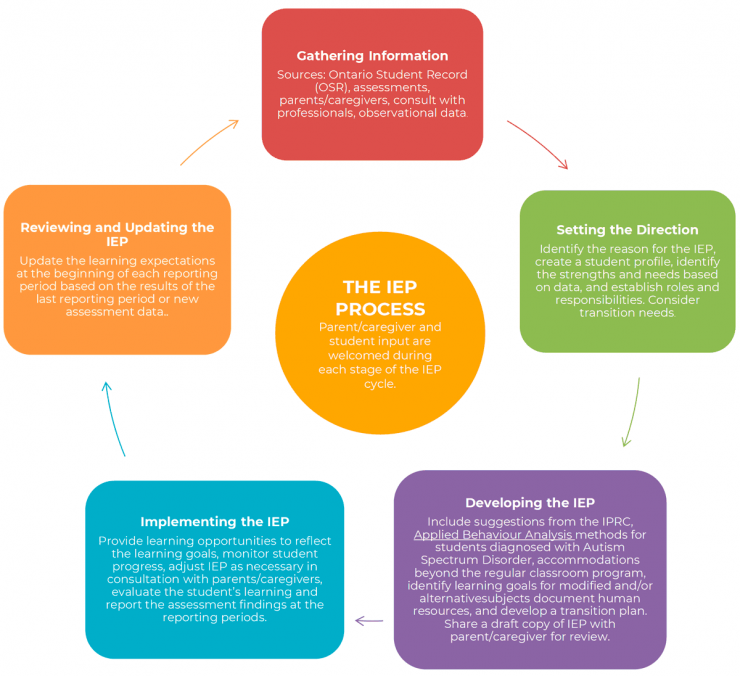Index
The Board's Consultation Process
The Board's General Model
for Special Education
Roles and Responsibilities
Early Identification Procedures and Intervention Strategies
The IPRC Process and Appeals
Education and Other Assessments
Specialized Health Support Services in School Settings
Categories and Definitions of Exceptionalities
Special Education Placements Provided by the Board
Individual Education Plans (IEP)
Provincial and Demonstration Schools in Ontario
Specialized Services Staff
Staff Development
Equipment
Accessibility of School Buildings
Transportation
Special Education Advisory Committee (SEAC)
Co-ordination of Services with Other Ministries or Agencies
Submission and Availability
of the Plan

Grand Erie Special Education Plan 2023-24
Standard 10
Individual Education Plans (IEP)
What Happens Before an IEP is put in Place?
The classroom educator facilitates on-going begins conversations with the caregiver(s) about concerns and collaborates on how to support the student in the classroom. When accommodations are above and beyond what is provided to all students, consideration about the development of an IEP may take place to document these provisions.
What is an IEP?
An IEP is a written plan describing the special education program(s), services, and/or resource(s) that are beyond what are provided through Universal Design for Learning and are essential to the student’s success.
An IEP is a working document that can be changed or adjusted at any point throughout the school year based on various assessments and data collected.
An IEP is a plan based on the strengths and needs of the student as informed by educational and/or clinical assessments.
An IEP identifies the special education programs (accommodations, modifications, and/or alternative programs), as well as supports, and services to assist student learning.
|
Accommodations |
|---|
|
|
Modified Programs |
|---|
|
|
Alternative Programs |
|---|
|
An IEP must include a statement by which the student’s progress will be reviewed (Regulation 181/98).
An IEP contains a Transition Plan which outlines goals for the student as they move from grade to grade, school and/or between school and the community once high school is completed (Program Policy Memorandum 156).
Developing an Individual Education Plan (IEP)
How Does the IEP Happen?
Curriculum is delivered through universal design for learning and differentiated instruction and assessment opportunities are provided. Accommodations that are good for all are also provided in classroom settings. If a student requires programs and services that go beyond this, an IEP may be developed. The IEP is developed in collaboration with the parent(s)/caregiver(s), the classroom educator(s), the Learning Resource Teacher (LRT), and Principal. Consideration for a modified IEP will occur no earlier than Grade 6.
IEPs are updated/completed, and a copy sent home at the following times and/or when there are changes made throughout the school year in collaboration with the caregiver(s) and/or the student:
|
|
Timelines |
Inclusions |
| IEP 1 |
Within the first thirty (30) days of the school year or semester in compliance with Ministry Guidelines. |
Program expectations for the first term or first semester – September to February. |
| IEP 2 |
With term 1 or semester 1 report cards |
Program expectations from February until the end of June (elementary) or semester 2 program expectations |
| IEP 3 |
With term 2 or semester 2 report cards |
Recommendations from the IPRC annual review Program expectations for term two or semester two are included for reflection on student achievement. |

The IEP process involves repeated review, evaluation, and adjustment throughout the school year. The goal of the individualized program for students on modified IEPs is to support the student to build skills to move them back to grade level. There should be a clear thread that begins at assessment data and is directly linked to the strengths and needs of the student. The link between the accommodations provided and/or learning expectations outlined in the IEP must be directly related to the needs of the student, with progress and growth reported to caregivers using the provincial progress report and report cards.
What is a Transition Plan?
The IEP Transition Plan outlines goals for the student as they move through significant transitions in their education. These transitions may include entry to school, grade to grade, school to school, school to community, and transitions throughout the day, where appropriate. Transitions align with Program/Policy Memorandum 156.
When a student has a diagnosis of autism spectrum disorder, the IEP must include a well-developed transition plan and utilize Applied Behaviour Analysis (ABA) methods in the program as per Program/Policy Memorandum 140.
The Caregiver Guide to Special Education - IEPs is available on the Grand Erie website.
What if I Disagree With My Child's IEP?
Caregivers may not agree with everything in an IEP or the focus may differ from requests provided to the educator or Principal. Schools are responsible for establishing a program that best suits a child’s strengths and needs while at school. The school principal is ultimately responsible for the initiation, implementation, and review of the IEP and ensuring that the caregiver parent is consulted in its development. The principal is not obliged to implement parental suggestion but must consider requests and provide rationale.
Collaboration between school staff and caregivers is essential. If you have a question or concern about your child’s learning or the IEP utilize the Parent/Caregiver/Community Member Concern Chart.
|
Classroom Educator The first step is to speak to the classroom educator as they are responsible for planning and delivering the program each day. |
The Learning Resource Teacher (LRT) The Learning Resource Teacher works with classroom educators to plan a special education program for your child. |
The Principal It is the principal’s responsibility to make sure that your child’s program is in place. The principal may need to consult with the Resource Team. |
.
.
